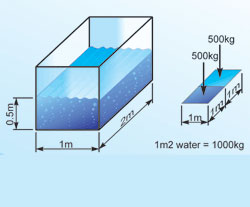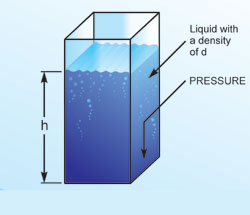
Full air conditioning implies the control of temperature and humidity levels within a conditioned space. Control of pressure is occasionally required for special applications. Air conditioning will always include the ability to reduce the temperature and humidity level of the air being processed. Most equipment will offer the option of heating to raise air temperature and more specialised equipment has an optional humidification facility to raise air humidity levels. Air conditioning also includes the control of motion of the air and the regulation of purity levels. This can be summarised as follows:

Fig 2: The relationship between force, area and pressure
Temperature
Air temperature is controlled by the removal (cooling) or addition (heating) of sensible heat energy.
Humidity
Air humidity level is determined by the moisture content and is controlled by the removal (dehumidification) or addition (humidification) of latent heat energy.
Purity
Air purity is a measure of cleanliness or air quality and is controlled by filtration and/or ventilation. Ventilation is the controlled introduction of outside (ambient) fresh air into the conditioned space to dilute the concentration of contaminants.
Motion
Motion or air movement covers the distribution and velocity of air introduced to the conditioned space. This is controlled by the air conditioning unit(s) or an air distribution system (ductwork and grilles).
Sound
Sound or noise control may be required to attenuate (reduce) the noise generated by the equipment and distribution system.
Air conditioning is normally applied to maintain the comfort and working efficiency of people or manufacturing, industrial and scientific processes. The combination of the above elements has generated the term HVAC but an air conditioning system need not include all these elements. For thousands of years mankind relied upon fires for heating and cool water for relief in high temperatures.
The Romans conceived an effective form of radiant heating in certain buildings by circulating heated air through hollow walls and floors. In the warmer climates of the Middle and Far East, wet mats suspended in open doorways provided evaporative cooling. The incredible Leonardo da Vinci designed and built an enormous evaporative cooler in the 15th century. This machine consisted of a large drum rotated by water power (or by slaves when available) which drew in air and supplied this to the conditioned space after washing and cooling the air inside the drum.
Only within the last hundred years has air conditioning become established and during this time the technology has developed to very advanced levels. Air conditioning is now a major industry throughout the world worth billions of pounds annually.
Temperature
The temperature reading for air given by a normal thermometer or digital thermometer is defined as dry bulb temperature (°C). The higher the sensible heat energy content of the air, the higher the dry bulb temperature.
Percentage saturation
This is the ratio of the actual moisture content of the air in relation to the maximum moisture content the air could support at the same dry bulb temperature. (Please note that the term relative humidity should not be used in this context.)
Human comfort
The objective of all comfort air conditioning installations and systems is to ensure the comfort of individuals in the conditioned zone and this is achieved by control of temperature and percentage saturation levels within prescribed limits. Following studies by ANSI (the American National Standards Institute) and ASHRAE (the American Society of Heating, Refrigeration and Air Conditioning Engineers), which measured the effects of temperature, humidity (percentage saturation), air motion and clothing on human comfort, the ANSI/ASHRAE Standard 55-1981 was developed. The results are very extensive but, for our general purposes, the ideal comfort envelope is as defined in Fig1.
Basic definitions and principles
This series of articles is based purely on SI units.
Mass
The mass of an object is the quantity of matter it contains. Unit of measure kg.
Force
Force is the push or pull exerted by one body on another. Unit of measure: N (Newton).
Weight
The weight of a body is equal to the force exerted upon it by the gravitational attraction of the Earth. At sea level, the Earth exerts a force of 9.81N on each kg of matter (N/kg). Force and weight are in fact different although the unit kg is used for both.
Density and specific volume
Density is the mass per unit volume of a substance and is expressed as kg/m3:

Specific volume defines the volume occupied per unit mass and is expressed as m3/kg:
Density and specific volume vary with temperature and pressure.
Specific gravity
Specific gravity (sg) is defined as the ratio of the weight of a substance in relation to the weight of an equal volume of water. As this is a ratio there are no units of expression.
Specific gravity changes with temperature. For non-scientific calculations this can usually be ignored. The density of water is l000kg/m3 (at 4°C).
Pressure
Pressure is given by unit force divided by area and is normally expressed as N/m2:
There are many units for the expression of pressure and these include kN/m2, Pa or kPa, mbar or bar and, of course, Ib/in2. Numerous factors exist for conversion from one unit to another.
Example: Fig 2 shows a tank containing 1m3 of water weighing 1000kg. The downward force due to gravity is equal to 9.81N/kg. The
total force exerted on the base of the tank is therefore 9810N.
Alternatively, this could be expressed as:
Atmospheric pressure
Atmospheric pressure is created by the gravitational force exerted upon the atmosphere throughout the full height of approximately 80km (50 miles). This results in an atmospheric pressure at sea level of approximately 1.01325bar (14.7psi).
Atmospheric pressure therefore decreases with increasing altitude due to the reduced weight of air above the measured point.
Atmospheric pressure is directly related to the density of the air and since this varies with temperature, atmospheric pressure also varies. This is measured by a barometer to indicate imminent weather changes.

Fig 3: pressure-zero, absolute, guage and vacuum
Absolute gauge and vacuum pressure
Absolute pressure (Pabs) is the pressure exerted by a gas or a liquid above zero pressure. Zero pressure exists when a space is fully evacuated of any gas or liquid.
Gauge pressure is measured by instruments that indicate a difference between the pressure of the atmosphere and the pressure of the gas or liquid. It is therefore necessary to add atmospheric pressure to gauge readings to establish absolute pressure.
Vacuum pressure is measured by instruments that indicate the difference between atmospheric pressure and zero pressure (see Fig 3).
A conventional pressure gauge reads the positive pressure of a gas or liquid above atmospheric pressure. A compound gauge is able to indicate both positive pressure and the negative pressure created by vacuum pressure (see Fig 4).

Fig 4
Pressure of a column of liquid
The pressure exerted by a column of liquid due to gravitational force is dependant upon the density of the liquid and the height of the column:
(see Fig 5)
Measurement of atmospheric pressure
Atmospheric pressure can be measured using a mercury barometer. The height (h) of the column of mercury (hg) supported by atmospheric pressure allows a direct pressure reading to be obtained and is normally indicated as inHg or mmHg (see Fig 6).

Fig 5: pressure exerted by a column of liquid
Work, power and energy
Work is described as the product of a force exerted upon a body resulting in motion. This is expressed as:
Example: A water chiller weighing 1000kg is lifted from ground level to the roof of a building. The vertical distance is 15m. The force applied is exerted against gravity. Weight in kg must therefore be converted to Newtons:
Power defines the rate at which work is applied or absorbed. Power is determined by:
Using the previous example, if the chiller is lifted to the roof in 5min(300s) the power required will be:-
Energy is defined as the ability to perform work. A body possesses energy when it has the capacity to perform work. Energy is measured in Joules and takes a number of forms:
Kinetic energy is the energy possessed by a body due to motion or velocity. Kinetic energy is given by:
Potential energy is the energy possessed by a body due to its position or configuration. The amount of work done by a body when moving from a given position or configuration to a reference position or condition is the measure of the body's potential energy and is given by:
Total external energy is the total of kinetic energy and potential energy possessed by a body.

Fig 6: Mercury barometer
Conversion of energy
The First Law of Thermodynamics basically states that the amount of energy in a thermodynamic system is constant and that none can be gained or lost unless it is converted from one form to another. Energy takes many forms including mechanical energy, electrical energy, chemical energy and heat energy. Energy cannot therefore be destroyed and is simply transferred from one body to another or converted in form.
With thanks to Mike Creamer of Business Edge who revisits his Masterclass series of articles, updating and adding to the information which proved so useful to readers when the series was first published over ten years ago. In this reincarnation, the series will cover both air conditioning and refrigeration and serve as an on-going source of technical reference for experienced personnel as well as providing a solid educational grounding for newcomers to our industry.